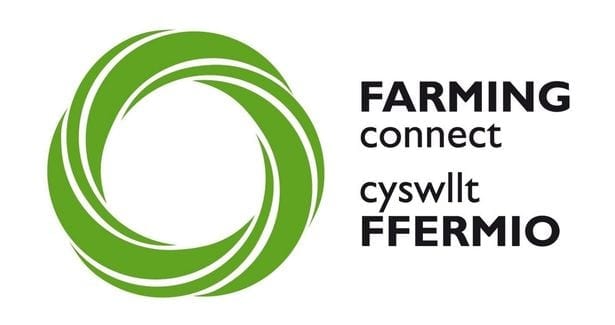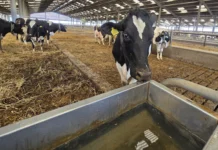Financial investment in vaccination pre-tupping to protect ewes on Welsh farms from abortion-causing pathogens can easily be recouped by a reduction in future flock barren and abortion rates.
Vet Cath Tudor says nearly a quarter of all lamb losses on Welsh farms are due to abortion yet Enzootic Abortion of Ewes (EAE) and toxoplasma can be controlled effectively by vaccination.
She advises farmers recording flock barren rates of over 2% to ask their vet to investigate whether a potential infectious cause of abortion is at the root of the problem.
The collection of data, such as losses between scanning and lambs sold, is key to informing an effective control plan to prevent losses next season.
“Keep records, more than two abortions in every 100 sheep is not normal,” Ms Tudor told farmers participating in an interactive webinar led by ProStock Vets and supported by the Welsh Government, Farming Connect, Lantra and NADIS.
During the event Ms Tudor and Miranda Timmerman of ProStock Vets advised farmers on how to minimise losses.
EAE and toxoplasmosis are the most commonly diagnosed causes of abortion in sheep – they account for two-thirds of all abortions.
Purchasing ewes or fostering with bought-in orphan lambs are the main causes of a flock becoming infected with EAE while toxoplasmosis is spread by infected cats.
Cats shed toxoplasma eggs in their faeces and sheep become infected when they ingest these eggs from contaminated pasture, feed and water.
Just 50g of faeces can contain 10 million oocysts with only 40 needed to infect a ewe: these oocysts will remain infective for 12 months.
It is therefore essential to keep sheep feed secure from cats.
“If you have young feral cats roaming around and messing in the feed that is bad news, if ewes eat the oocysts they will abort,” Ms Tudor warned.
If possible, neuter cats as these are less likely to shed oocysts.
Once a ewe aborts due to toxoplasmosis she usually has immunity, said Ms Tudor.
Ewes with EAE pass their infected status on to their female progeny.
Careful planning is needed around lambing time, said Ms Timmerman.
“If you are lambing in two groups and there are abortions in the first batch you will need to lamb the second batch elsewhere because the infection will be passed onto those ewes from the environment,” said Ms Timmerman.
Clean and disinfect pens where sheep have aborted – people who have had contact with the ewe and the pen should also disinfect themselves.
Analysis of abortion material, including the foetus, foetal fluids and most importantly of all the placenta, is critical to establish the cause.
In Wales, diagnosis can be made at AHVLA laboratories at Carmarthen and Aberystwyth and for farmers in mid Wales, at Shrewsbury, or at other private laboratories.
Blood testing should also be considered if there are a high proportion of barren ewes at scanning.
Sampling, testing and one-to-one advice from local vets is available for Welsh farm businesses registered with Farming Connect.
“We can test ewes for free through the Farming Connect Animal Health Clinics, so if sheep do abort, mark them and we can take blood samples,” said Ms Tudor.
Farmers are encouraged to ask their local veterinary practice for further information, or contact Farming Connect directly.
Isolate ewes that have aborted as the EAE organism will be shed by vaginal discharge for many weeks.
A ewe may lose one foetus but produce a live lamb too. “These pose the greatest risk of infection because the farmer will often not know that it is a true abortion,” said Ms Tudor.
She advised against breeding from the ewe lambs of infected ewes or fostering a lamb onto a ewe that has aborted.
If replacements are bought-in, only purchase from EAE accredited flocks, she recommended. “Try to buy from the same source every year.”
Although ewes with EAE can be treated with antibiotics, Ms Tudor said this was a policy to be avoided.
“It is a big no-no to give antibiotics to every ewe when there is a very good vaccine for preventing infection,” she said.
“It is a good idea to cull ewes that have had the infection because they can abort the following year as they will still have infection in their system.”
If a ewe aborts in a field, disinfect the area with a soil-safe product, advised Ms Timmerman.
“You can’t dig up the ground but it is still worth disinfecting that area, not everyone has the luxury of moving sheep from that field.”
Both EAE and toxoplasmosis are highly contagious and can be passed to humans so it is vital that pregnant women avoid contact with sheep. There is also a risk to other individuals as infection can cause flu-like symptoms.
Another cause of abortion in both sheep and cattle, salmonella, can also be passed to humans.
Flocks and herds in coastal regions of Wales are more likely to be infected as seabirds can carry and transmit salmonella, Ms Timmerman suggests.
It is also often present in cattle slurry, especially dairy slurry, which is sometimes spread on lambing fields.
“If you have salmonella around lambing time you will have a lot of really sick ewes,” said Ms Timmerman.
Vaccination of sheep is key to preventing abortions from EAE and toxoplasmosis.
Protection against EAE from a vaccine administered at least four weeks prior to tupping lasts for three years therefore for many flocks it is a ‘once in a lifetime’ cost while immunity in ewes vaccinated for toxoplasmosis before mating lasts for around 18 months.
“It is an investment worth making because the heartache and hassle at lambing is not what you need at your busiest time of the year,” said Ms Tudor.
Farming Connect, which is delivered by Menter a Busnes and Lantra, has received funding through the Welsh Government Rural Communities – Rural Development Programme 2014-2020, which is funded by the European Agricultural Fund for Rural Development and the Welsh Government.

| [donate]
| Help keep news FREE for our readersSupporting your local community newspaper/online news outlet is crucial now more than ever. If you believe in independent journalism,then consider making a valuable contribution by making a one-time or monthly donation. We operate in rural areas where providing unbiased news can be challenging. |


















